Cassin's auklet facts for kids
Quick facts for kids Cassin's auklet |
|
|---|---|
 |
|
| Conservation status | |
| Scientific classification | |
| Genus: |
Ptychoramphus
|
| Species: |
aleuticus
|
 |
|
The Cassin's auklet (scientific name: Ptychoramphus aleuticus) is a small, plump seabird. It lives in the North Pacific region. This bird is quite well-known because it nests on islands that scientists study often. These islands are found in British Columbia and off the coast of California. The bird is named after an American bird expert, John Cassin.
Cassin's auklets are small, about 25 centimeters (10 inches) long and weighing around 200 grams (7 ounces). Their feathers are dark on top and lighter underneath. They have a small white spot above each eye. Their beak is dark with a light spot, and their feet are blue. Unlike some other seabirds, the Cassin's auklet looks the same all year round. When flying over the sea, people often say it looks like a flying tennis ball!
These birds live along the coast of North America. Their range stretches from the middle of the Baja California peninsula up to Alaska's Aleutian Islands. They build their nests on islands away from the mainland. A very large group of them lives on Triangle Island near Vancouver Island in Cape Scott Provincial Park. About 550,000 pairs of Cassin's auklets live there! These birds usually don't migrate far. However, birds from the northern areas might fly a bit further south during winter.
There are two main types, or subspecies, of Cassin's auklets:
- P. a. aleuticus: These are found from the Aleutian Islands and southern Alaska down to northern Baja California.
- P. a. australis: These live in southern Baja California.
Scientists have also found fossils of an older, extinct relative of the Cassin's auklet. It was called Ptychoramphus tenuis. These fossils were found in California and date back to the Late Pliocene period.
Contents
How Cassin's Auklets Live
Cassin's auklets make their nests in burrows on small islands. In the warmer southern parts of their range, they might stay at their nesting colony all year. They dig holes in the soil or use natural cracks in rocks. They can also use man-made structures for nesting.
Nesting and Raising Chicks
Cassin's auklet pairs are very loyal to each other and to their nesting spot. They often use the same spot for many years. Both parents take turns sitting on their single white egg. They switch shifts at night, usually after 11 PM. This helps them avoid predators like western gulls or peregrine falcons. They also leave the colony before the sun comes up.
The egg takes about 40 days to hatch. Once the chick is born, both parents feed it every night for about 35 days. They bring back partially digested food, mostly small krill and other tiny ocean creatures. They carry this food in a special pouch in their throat. When the chick is ready, it leaves the nest by itself and heads to the sea. Cassin's auklets are special because they sometimes lay a second set of eggs after their first chicks have successfully hatched. They are the only seabird in the northern half of the world to do this!
What They Eat
At sea, Cassin's auklets look for food far from shore in clear ocean waters. They often gather near underwater canyons or areas where deep, nutrient-rich water rises to the surface. It can be hard to count how many of these birds are at sea because they tend to fly away from ships.
They find their food by diving underwater. They use their wings to swim and catch large zooplankton, especially krill. They can dive as deep as 30 meters (about 100 feet) and some scientists think they can go even deeper, up to 80 meters (about 260 feet)!
Protecting Cassin's Auklets
The Cassin's auklet is currently listed as "Near Threatened." This means their populations could be at risk in the future. Some groups of these birds, like those near the Farallon Islands, have seen their numbers drop a lot.
Threats to Their Survival
Several things can harm Cassin's auklets:
- Introduced animals: Predators like rats or foxes that are brought to islands can eat their eggs and chicks. This is a big problem in Alaska.
- Oil spills: Oil in the ocean can cover their feathers, making it hard for them to fly and stay warm.
- Changes in ocean temperature: Events like El Niño can make the ocean warmer. This affects the tiny sea creatures that the auklets eat, making it harder for them to find food.
The Cassin's auklet is protected by the Migratory Bird Treaty Act of 1918 in the United States. Scientists have found that changes in ocean climate can affect many parts of their lives, including how many survive, how often they breed, and how many chicks they successfully raise. This means that climate change could cause their populations to decline quickly.
Why Some Died in 2014
In late 2014, many thousands of Cassin's auklets died. Their bodies washed ashore from Northern California up to Washington State. The Coastal Observation and Seabird Survey Team estimated that between 50,000 and 100,000 birds died that year.
Scientists were not sure exactly why so many birds died. They checked for viruses, bacteria, and oil spills, but these were ruled out. It seemed the main reason was starvation. Scientists found very little food in the stomachs of the dead birds. Some scientists believe these mass deaths might be linked to unusually warm ocean waters in the North Pacific. This warmth could have affected the food chain, impacting the tiny zooplankton, krill, and fish that the auklets normally eat. This event happened when the young auklet chicks were just starting to leave their nests.
See also
 In Spanish: Mérgulo sombrío para niños
In Spanish: Mérgulo sombrío para niños


